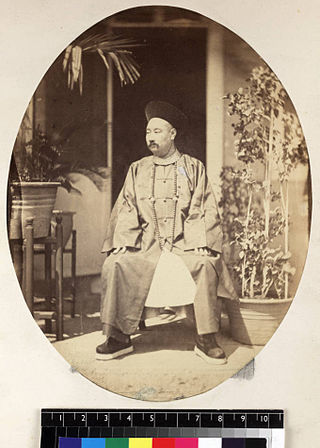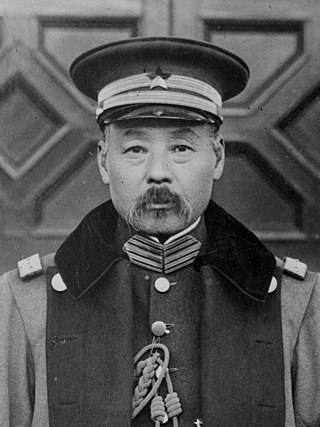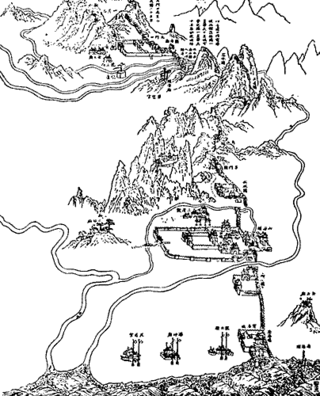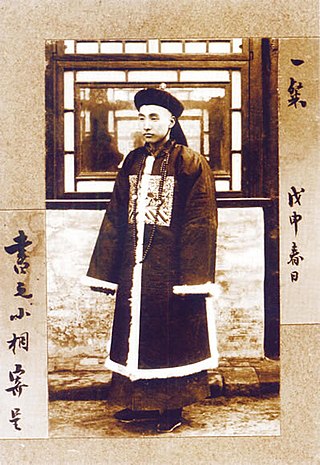Related Research Articles

The Qing dynasty, officially the Great Qing, was a Manchu-led imperial dynasty of China and as an early modern empire it is widely considered the last imperial dynasty in Chinese history. Originally emerging from the Later Jin dynasty founded in 1616 and proclaimed in Shenyang in 1636, the dynasty seized control of Beijing in 1644, traditionally considered the start of the dynasty's rule. The dynasty lasted until the Xinhai Revolution of October 1911 led to the abdication of the last emperor in February 1912. In Chinese historiography, the Qing dynasty was preceded by the Ming dynasty and succeeded by the Republic of China. The multi-ethnic Qing dynasty assembled the territorial base for modern China. It was the largest imperial dynasty in Chinese history and in 1790 the fourth-largest empire in world history in terms of territorial size. With over 426 million citizens in 1907, it was the most populous country in the world at the time.
The Eight Banners were administrative and military divisions under the Later Jin and Qing dynasties of China into which all Manchu households were placed. In war, the Eight Banners functioned as armies, but the banner system was also the basic organizational framework of all of Manchu society. Created in the early 17th century by Nurhaci, the banner armies played an instrumental role in his unification of the fragmented Jurchen people and in the Qing dynasty's conquest of the Ming dynasty.

Sushun, courtesy name Yuting, was a Manchu noble and politician of the Qing dynasty. He was born in the Aisin Gioro clan, the imperial clan of the Qing dynasty, as the sixth son of Ulgungga. Ulgungga was distantly related to the Qing dynasty emperors and was the 12th heir to the Prince Zheng line, one of the "iron-cap" princely peerages of the Qing dynasty. Since the line of Prince Zheng was in charge of the Bordered Blue Banner, Sushun was a member of this banner. Sushun was a supporter of Zeng Guofan and Li Hongzhang but also characterized by his firm policy against the West.

The Shunzhi Emperor, also known by his temple name Emperor Shizu of Qing, personal name Fulin, was the third emperor of the Qing dynasty, and the first Qing emperor to rule over China proper. Upon the death of his father Hong Taiji, a committee of Manchu princes chose the 5-year-old Fulin as successor. The princes also appointed two co-regents: Dorgon, the 14th son of Nurhaci, and Jirgalang, one of Nurhaci's nephews, both of whom were members of the Qing imperial clan. In November 1644, the Shunzhi Emperor was enthroned as emperor of China in Beijing.

The Yongzheng Emperor, also known by his temple name Emperor Shizong of Qing, personal name Yinzhen, was the fifth emperor of the Qing dynasty, and the third Qing emperor to rule over China proper.

The House of Aisin-Gioro is a Manchu clan that ruled the Later Jin dynasty (1616–1636), the Qing dynasty (1636–1912), and Manchukuo (1932–1945) in the history of China. Under the Ming dynasty, members of the Aisin Gioro clan served as chiefs of the Jianzhou Jurchens, one of the three major Jurchen tribes at this time. Qing bannermen passed through the gates of the Great Wall in 1644, and eventually conquered the short-lived Shun dynasty, Xi dynasty and Southern Ming dynasty. After gaining total control of China proper, the Qing dynasty later expanded into other adjacent regions, including Xinjiang, Tibet, Outer Mongolia, and Taiwan. The dynasty reached its zenith during the High Qing era and under the Qianlong Emperor, who reigned from 1735 to 1796. This reign was followed by a century of gradual decline.
Hešeri, is a clan of Manchu nobility with Jianzhou Jurchens roots, originally hailing from the area which is now the modern Chinese provinces of Jilin and Liaoning. It was once one of the most important and powerful noble families in the early Qing dynasty in China, second only to the royal House of Aisin Gioro, to whom they were closely related by marriage.

Keying, also known by his romanized Mandarin Chinese name Qiying or Ch'i-ying (Wade–Giles) and his Manchu name Kiyeng, was a Manchu statesman during the Qing dynasty of China. An imperial clansman of the house of Aisin Gioro, he began his career in the Imperial Clan Court. He conducted several peace treaties with Western powers, beginning with the Treaty of Nanking, which ended the First Opium War with Britain in 1842. Keying was sent to negotiate again in 1858 to settle the Arrow War with Britain and France, but the settlement was repudiated by the Xianfeng Emperor and he was forced to commit suicide.

Amban is a Manchu language term meaning "high official", corresponding to a number of different official titles in the imperial government of Qing China. For instance, members of the Grand Council were called Coohai nashūn-i amban in the Manchu language and Qing governor-generals were called Uheri kadalara amban.
Longkodo was a Manchu court official who lived in the Qing dynasty. He was from the Tunggiya clan, which was under the Bordered Yellow Banner. His period of fame lasted from the late Kangxi era to the early Yongzheng era, perhaps most famous for delivering the Kangxi Emperor's disputed will.

Wenxiang was an ethnic Manchu statesman of the Qing dynasty of China. Wenxiang hailed from the Gūwalgiya clan and belonged to the Plain Red Banner in the Eight Banners in Mukden. In 1845, he obtained the highest degree (jinshi) in the imperial examination and four years later he was appointed to the Board of Works. He advanced through the ranks and in 1858, he was appointed vice president to the Board of Rites and also became a member of the Grand Council, the highest policy-making organ in the Empire. He subsequently held a number of prominent posts in the central government and became a key player in court politics.

Ronglu, courtesy name Zhonghua, was a Manchu political and military leader of the late Qing dynasty. He was born in the Guwalgiya clan, which was under the Plain White Banner of the Manchu Eight Banners. Deeply favoured by Empress Dowager Cixi, he served in a number of important civil and military positions in the Qing government, including the Zongli Yamen, Grand Council, Grand Secretary, Viceroy of Zhili, Beiyang Trade Minister, Secretary of Defence, Nine Gates Infantry Commander, and Wuwei Corps Commander. He was also the maternal grandfather of Puyi, the last Emperor of China and the Qing dynasty.

Mongolia under Qing rule was the rule of the Manchu-led Qing dynasty of China over the Mongolian Plateau, including the four Outer Mongolian aimags and the six Inner Mongolian aimags from the 17th century to the end of the dynasty. The term "Mongolia" is used here in the broader historical sense, and includes an area much larger than the modern-day state of Mongolia. By the early 1630s Ligdan Khan saw much of his power weakened due to the disunity of the Mongol tribes. He was subsequently defeated by the Later Jin dynasty and died soon afterwards. His son Ejei handed the Yuan imperial seal over to Hong Taiji in 1635, thus ending the rule of the Northern Yuan dynasty in Inner Mongolia. However, the Khalkha Mongols in Outer Mongolia continued to rule until they were overrun by the Dzungar Khanate in 1690, and they submitted to the Qing dynasty in 1691.

Ortai (1680–1745) was the first Earl Xiangqin. He was an eminent Manchu official from the Sirin Gioro clan, belonging to the Bordered Blue Banner, during the Qing dynasty (1644–1911). He served both the Yongzheng Emperor and the Qianlong Emperor. Ortai governed the southwestern region of the Qing empire, Yun-Gui, from around 1726–1731, and was responsible for putting down several Miao uprisings. He fell ill and died in 1745.

Feng Guozhang was a Chinese general and politician in the late Qing dynasty and early republican China who was Vice President from 1916 to 1917 and then acting President of the Republic of China from 1917 to 1918. He emerged as one of the senior commanders of the Beiyang Army and is considered the founder of one of the main warlord factions, the Zhili clique, that vied for control of the internationally recognized government in China during the Warlord Era.
The Deliberative Council of Princes and Ministers, also known as the Council of Princes and High Officials and Assembly of Princes and High Officials, or simply as the Deliberative Council, was an advisory body for the emperors of the early Qing dynasty (1644–1912). Derived from informal deliberative groups created by Nurhaci (1559–1626) in the 1610s and early 1620s, the Council was formally established by his son and successor Hong Taiji (1592–1643) in 1626 and expanded in 1637. Staffed mainly by Manchu dignitaries, this aristocratic institution served as the chief source of advice on military matters for Hong Taiji and the Shunzhi and Kangxi emperors. It was particularly powerful during the regencies of Dorgon (1643–1650) and Oboi (1661–1669), who used it to enhance their personal influence.
The history of the Qing dynasty began in the first half of the 17th century, when the Qing dynasty was established and became the last imperial dynasty of China, succeeding the Ming dynasty (1368–1644). The Manchu leader Hong Taiji renamed the Later Jin established by his father Nurhaci to "Great Qing" in 1636, sometimes referred to as the Predynastic Qing in historiography. By 1644 the Shunzhi Emperor and his prince regent seized control of the Ming capital Beijing, and the year 1644 is generally considered the start of the dynasty's rule. The Qing dynasty lasted until 1912, when Puyi abdicated the throne in response to the 1911 Revolution. As the final imperial dynasty in Chinese history, the Qing dynasty reached heights of power unlike any of the Chinese dynasties which preceded it, engaging in large-scale territorial expansion which ended with embarrassing defeat and humiliation to the foreign powers whom they believe to be inferior to them. The Qing dynasty's inability to successfully counter Western and Japanese imperialism ultimately led to its downfall, and the instability which emerged in China during the final years of the dynasty ultimately paved the way for the Warlord Era.

The transition from Ming to Qing or the Manchu conquest of China from 1618 to 1683 saw the transition between two major dynasties in Chinese history. It was a decades-long conflict between the emerging Qing dynasty, the incumbent Ming dynasty, and several smaller factions. It ended with the consolidation of Qing rule, and the fall of the Ming and several other factions.

Yinchang or In-ch'ang was a Chinese military official, ambassador to Germany, and educational reformer in the Qing dynasty and the Republic of China. He was appointed the nation's first Minister of War in the late Qing dynasty. During the Republic he served as the military Chief of Staff for all of the subsequent presidents in the Beiyang Government. He was ethnic Manchu, and his family belonged to the Plain White Banner Clan of the Manchu Military Organization (滿洲正白旗); he held the title of Prince of the Plain White Banner Clan; at court he was addressed as Wu-lou (五/午楼).

The Qing dynasty (1644–1912) was the last imperial dynasty of China. The early Qing emperors adopted the bureaucratic structures and institutions from the preceding Ming dynasty but split rule between the Han and Manchus with some positions also given to Mongols. Like previous dynasties, the Qing recruited officials via the imperial examination system until the system was abolished in 1905. The Qing divided the positions into civil and military positions, each having nine grades or ranks, each subdivided into a and b categories. Civil appointments ranged from an attendant to the emperor or a grand secretary in the Forbidden City (highest) to being a prefectural tax collector, deputy jail warden, deputy police commissioner, or tax examiner. Military appointments ranged from being a field marshal or chamberlain of the imperial bodyguard to a third class sergeant, corporal or a first or second class private.
References
- ↑ The Chinese Repository, Volume 14, edited by Elijah Coleman Bridgman, Samuel Wells Williams